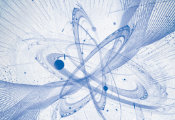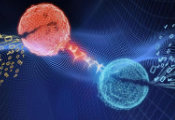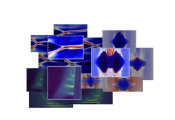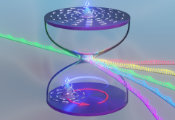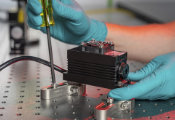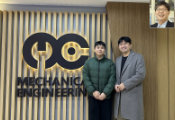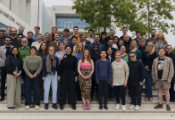Quantum Leap in 2D Semiconductors: Purdue Team Unlocks Room-Temperature Spin Qubits in GeS₂
September 17, 2025 -- For decades, researchers have searched for materials that can host stable qubits, the building blocks of quantum computers, at room temperature. A team at Purdue University has now demonstrated just that in a two-dimensional semiconductor, opening a new frontier for quantum sensing and computing.
In a study recently accepted by Nano Letters, researchers found that the layered material germanium disulfide (GeS₂) can host controllable spin defects, or tiny imperfections that trap electrons with magnetic properties, that remain stable at ambient conditions. These defects act as qubits, storing and processing quantum information in ways that could one day lead to molecular-scale imaging, advanced sensors, and even room-temperature quantum computers.
This discovery, led by Tongcang Li, professor of physics and astronomy and professor of electrical and computer engineering at Purdue, has been published in Nano Letters, a leading journal in nanoscience and nanotechnology.
Joining Li on the Purdue team were graduate student Sumukh Vaidya, postdoctoral researcher Xingyu Gao, graduate student Saakshi Dikshit, postdoctoral researcher Andres E. Llacsahuanga Allcca, and Yong P. Chen, professor of physics and electrical and computer engineering. Collaborators included Zhenyao Fang, a graduate student at Northeastern University, and Qimin Yan, professor of physics at Northeastern.
"We have found that the 2D material β-GeS₂ can host room temperature qubits," Vaidya said. "It also has a potential for a very low amount of environmental noise, so it is possible to do long-lasting quantum sensing and quantum computing at room temperature with this material."
In the experiments, the researchers not only demonstrated coherent control of spins in GeS₂, but also extended their memory time twenty-fold using microwave pulses. That advance, Vaidya said, broadens the field of 2D quantum materials beyond the well-studied hexagonal boron nitride, a breakthrough with far-reaching implications.
The team's broader research program explores quantum sensing with van der Waals materials. These are crystals that can be exfoliated into sheets only a few atoms thick. "Our aim is to develop quantum sensors for magnetic fields, temperature, and ion concentrations in liquids," Vaidya explained. "2D materials are of interest due to their ease of integration into existing semiconductor technology processes."
The work was made possible by Purdue's collaborative culture and advanced research infrastructure. The Birck Nanoscience Center provided cutting-edge nanofabrication and sample analysis tools, while Purdue's strong connections with national research centers fueled innovation. The team is also affiliated with the DOE Quantum Photonics Integrated Design Center and the DOE Quantum Science Center. In addition, Li serves as director of the NSF IUCRC Center for Quantum Technologies.
To illustrate the potential impact, Vaidya offered a simple analogy. "In typical 2D materials like hexagonal boron nitride, you have a lot of environmental noise, which reduces the effectiveness of your sensors. In GeS₂ we expect much lesser noise due to nuclear spins, which can help sense weak signals with greater precision."
With further research, these optically active qubits could pave the way for quantum networks and enable high-precision quantum sensors for industry applications. "This work shows that new qubits in 2D semiconductors like GeS₂ can unlock opportunities we hadn't imagined before," Li said.
Funding for the project came from the Gordon and Betty Moore Foundation, the U.S. Department of Energy's Quantum Photonics Integrated Design Center and Quantum Science Center, and the National Science Foundation.

